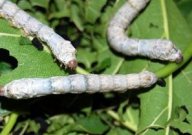Science & Technology
July 13, 2013 · 2 comments
2 comments

Image Credit: CC 3.0 Fastily
The project was particularly important from the perspective of developing more sophisticated 3D printers. "The silkworm embodies everything an additive fabrication system currently lacks," said Media Lab professor Neri Oxman. "It jets a structural material with superior function-specific variable properties; it's small in size and mobile in movement; and it can spin, rather than print, non-homogeneous fibrous structures without waste."[!gad]Known as the 'Silk Pavilion', the silk-based structure was created using 6,500 silkworms. At the core of the project is the use of a special computer-based control mechanism that is capable of guiding the silkworms to produce specific patterns of silk. By combining this with an aluminum scaffold and a lattice of starter threads the team were able to entice the silkworms in to creating the rest of the structure.
The project was particularly important from the perspective of developing more sophisticated 3D printers. "The silkworm embodies everything an additive fabrication system currently lacks," said Media Lab professor Neri Oxman. "It jets a structural material with superior function-specific variable properties; it's small in size and mobile in movement; and it can spin, rather than print, non-homogeneous fibrous structures without waste."
Source: Wired | Comments (2)
'3-D printed' dome uses 6,500 live silkworms
By T.K. RandallJuly 13, 2013 ·
 2 comments
2 comments
Image Credit: CC 3.0 Fastily
An experiment at the Massachusetts Institute of Technology has produced a remarkable silk dome.
Known as the 'Silk Pavilion', the silk-based structure was created using 6,500 silkworms. At the core of the project is the use of a special computer-based control mechanism that is capable of guiding the silkworms to produce specific patterns of silk. By combining this with an aluminum scaffold and a lattice of starter threads the team were able to entice the silkworms in to creating the rest of the structure.The project was particularly important from the perspective of developing more sophisticated 3D printers. "The silkworm embodies everything an additive fabrication system currently lacks," said Media Lab professor Neri Oxman. "It jets a structural material with superior function-specific variable properties; it's small in size and mobile in movement; and it can spin, rather than print, non-homogeneous fibrous structures without waste."[!gad]Known as the 'Silk Pavilion', the silk-based structure was created using 6,500 silkworms. At the core of the project is the use of a special computer-based control mechanism that is capable of guiding the silkworms to produce specific patterns of silk. By combining this with an aluminum scaffold and a lattice of starter threads the team were able to entice the silkworms in to creating the rest of the structure.
The project was particularly important from the perspective of developing more sophisticated 3D printers. "The silkworm embodies everything an additive fabrication system currently lacks," said Media Lab professor Neri Oxman. "It jets a structural material with superior function-specific variable properties; it's small in size and mobile in movement; and it can spin, rather than print, non-homogeneous fibrous structures without waste."
Humans have been breeding silkworms for fabric for over 5,000 years, but Media Lab professor Neri Oxman married their innate productivity with computerized efficiency.
Source: Wired | Comments (2)

The Unexplained Mysteries
Book of Weird News
AVAILABLE NOW
Take a walk on the weird side with this compilation of some of the weirdest stories ever to grace the pages of a newspaper.
Click here to learn more

Support us on Patreon
BONUS CONTENTFor less than the cost of a cup of coffee, you can gain access to a wide range of exclusive perks including our popular 'Lost Ghost Stories' series.
Click here to learn more
Spirituality, Religion and Beliefs
Ancient Mysteries and Alternative History
Israel, Palestine and the Middle-East
United States and the Americas
Total Posts: 7,607,290 Topics: 316,435 Members: 201,852
Not a member yet ? Click here to join - registration is free and only takes a moment!
Not a member yet ? Click here to join - registration is free and only takes a moment!




















Please Login or Register to post a comment.